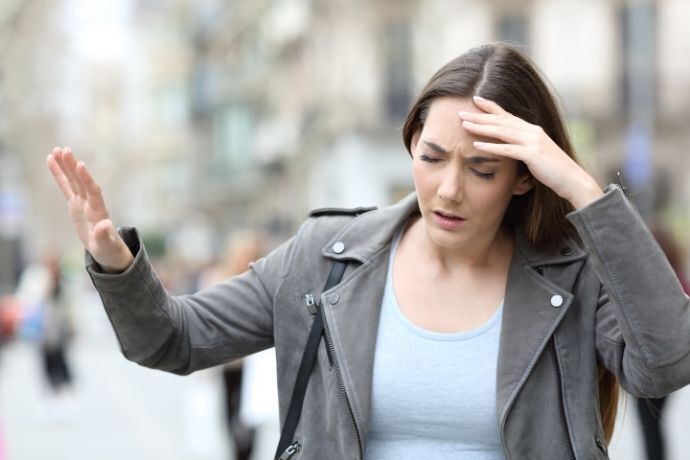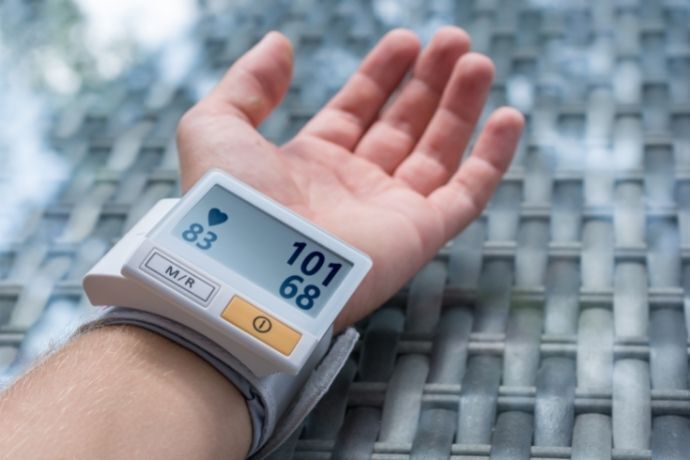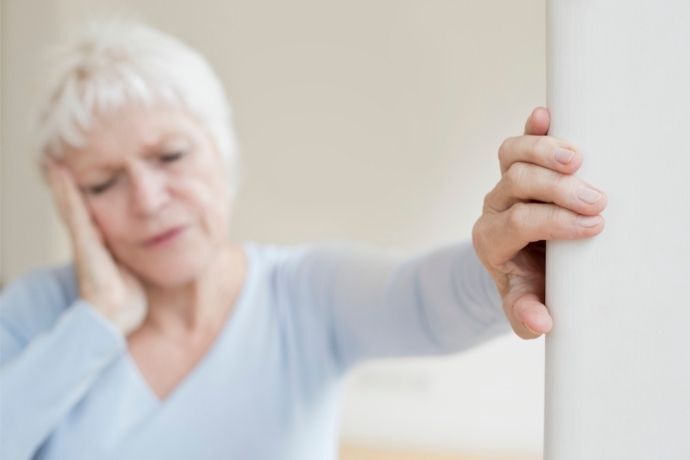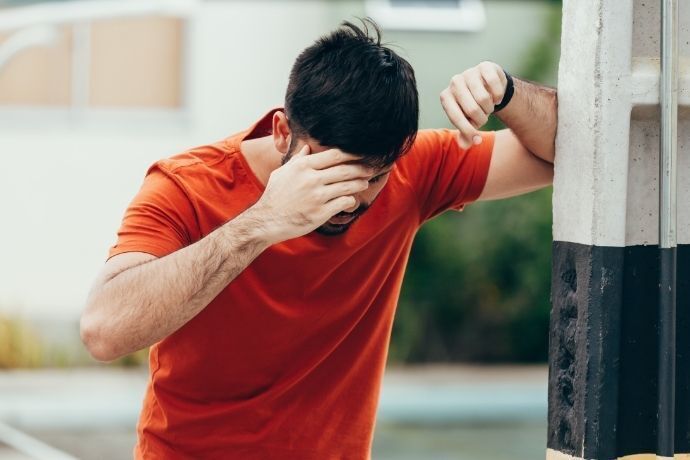Table of contents
General considerations about the symptoms of low blood pressure

Low blood pressure can be defined as an insufficient amount of blood flowing from the heart to the other organs. It is considered low when its values are less than or equal to 90 x 60 mmHg. In some cases, this condition has no symptoms.
However, when falls become sudden, it is possible to notice symptoms such as dizziness, muscle weakness, faintness, and headaches.
Throughout the article more details about the risks, symptoms and main causes of low blood pressure will be commented on. If you want to know more about it, read on.
Low blood pressure, symptoms and risks

Also known as hypotension, low blood pressure can cause fainting and is not considered a disease per se. However, it can be directly related to serious health conditions, so it is important to understand its main symptoms, its risks, and when it should receive special attention. Learn more about these and other aspects of this condition below!
What is low blood pressure or hypotension
Low blood pressure occurs when the amount of blood flowing from the heart to the other organs in the body is insufficient. To be considered low, it must be 90 x 60 mmHg or less, which is 9 x 6 in the most popular language.
It is safe to say that hypotension cannot be considered a health condition. Some people go their whole lives living with it without manifesting any symptoms. However, because of its association with serious diseases, such as pulmonary embolism, low blood pressure must be looked at closely.
What are the symptoms of low blood pressure?
The symptoms of low blood pressure are quite diverse. It is common for people to feel tired and have difficulty concentrating. They may also experience dizziness, lack of energy, and muscle weakness, leading to the faintness often associated with this condition.
In addition, it is common for those with low blood pressure to have exaggerated drowsiness. Another symptom that can manifest itself is blurred or blurred vision. In most cases, the symptoms appear simultaneously and require some care to be taken to alleviate them.
The Risks of Low Blood Pressure
Although low blood pressure is less of a concern than high blood pressure, there are some risks associated with this condition. When the condition becomes recurrent, it means that it is associated with other issues, ranging from vitamin deficiencies to dehydration.
In the case of vitamins, B12 and folic acid are the main ones linked to pressure, since both are responsible for the formation of red blood cells. Therefore, their lack can cause anemia and pressure drops. Therefore, when symptoms such as weakness become recurrent and someone has hypotension, the condition needs to be analyzed more carefully.
The risks of low blood pressure during pregnancy
The main risk of low blood pressure during pregnancy is fainting, which can result in falls and, in more serious cases, can lead to trauma. Moreover, this possibility poses risks to the baby's life and therefore attention is required.
These episodes of pressure drops can be frequent in early pregnancy, but once the body adapts and the blood volume is normalized, the pressure tends to return to what it was before. Therefore, attention should be redoubled in the first months and women should avoid going out unaccompanied.
Is it dangerous to have low blood pressure?
Low blood pressure in itself is not dangerous; some people can go their whole lives with the condition without ever showing symptoms, so it only becomes a concern when falls become more frequent, as this scenario highlights other health conditions.
Therefore, to avoid pressure drop situations, try not to fast for long periods. Also, do not stay in stuffy places for very long periods. Another point that should be reinforced is the need to pay attention to food.
Who to watch out for
Although low blood pressure is not dangerous in itself, there are some groups of people who should pay attention to this disease, such as pregnant women. Thus, to avoid this situation, it is also necessary to pay attention to the amounts of folic acid ingested.
It is very common for this vitamin to need supplementation during pregnancy, since the amounts needed for the development of the fetus are much higher than what an adult woman normally needs. Therefore, it is necessary to consult a doctor to determine these values.
The differences between hypotension and hypertension
While hypotension is characterized by low blood pressure values and cannot be considered a disease in itself, hypertension does the opposite. Thus, you have the elevation of these numbers, which need to be above 140 x 90 mmHg. It is a silent disease and does not cause symptoms, but it can cause changes in the body.
Treatment for hypertension includes changes in diet, especially reducing the amounts of salt ingested. However, it may also be necessary to take specific medications for the treatment of the condition.
The most common causes of low blood pressure

To be able to identify the cases of low blood pressure, it is necessary to know well its symptoms, which can range from dehydration to the presence of infections in the body. Thus, these issues will be detailed throughout the next section of the article. If you want to know more about it, just continue reading to inform yourself.
Dehydration
When the body loses more water than it receives, dehydration appears. This happens because the blood vessels have less blood inside them, and therefore the pressure drops. Thus, symptoms such as fainting, fatigue, and weakness can appear.
It is worth pointing out that dehydration is more common in the elderly and in children. It happens during the summer, but it can also appear in people who take diuretic medicines.
To achieve rehydration and to get around this issue, it is recommended to make homemade serum. However, in more severe cases, it is necessary to visit the hospital to receive serum directly into the vein.
B12 deficiency
Vitamin B12 deficiency can be one of the causes of high blood pressure. This is because this compound, as well as other B vitamins, is directly related to the production of red blood cells, so when it is missing, pressure drops can occur. In addition, the lack of these cells can lead to diseases such as anemia.
There are some symptoms that can identify this disease and, consequently, the low blood pressure caused by the lack of vitamin B12. Among them are pallor, tingling in the extremities of the body, stiffness in the arms and legs, and loss of sensitivity to touch.
Medications
Some types of medications, especially when used for a long time, can cause low blood pressure. Among them are diuretics, medications for heart problems, medications for high blood pressure, antidepressants, and medications for erectile dysfunction.
If someone who regularly uses these drugs notices a recurrence of low blood pressure, the best thing to do is to consult the prescribing physician for an evaluation. He or she will be able to determine a change or even make dose adjustments.
Hormonal change and bleeding
When the hormones produced by the thyroid undergo some kind of alteration, the blood vessels may dilate. This ends up causing episodes of falling blood pressure. Another issue that interferes with the hormones and can generate these conditions is pregnancy.
In addition, it is worth noting that internal bleeding, because it leaves the blood vessels with less blood, ends up causing this type of situation. In this case, the most frequent symptoms are headaches, dizziness, weakness, and difficulty breathing.
So, in cases of suspected internal bleeding, the best thing to do is to seek a hospital so that the site of bleeding can be identified and properly treated.
Infections
Severe infections can cause pressure drops, although this is rare. When this happens, bacteria spread throughout the body and release a series of toxins that compromise the blood vessels. Therefore, the pressure experiences a drop.
So anyone who notices an infection in a certain region of the body should seek medical attention, especially if they notice a drop in pressure following the infection. Otherwise symptoms such as fainting, weakness, and dizziness may appear. Treatment in this case is done with antibiotics directly into the vein.
What to do when the pressure is low

There are some precautions that can help in cases of pressure drop, such as avoiding crowds and enclosed places. In addition, drinking water and some foods also helps normalize blood pressure. Below, these and other precautions to improve falls will be commented on. Read on to learn more.
Drink water
In the case of sudden pressure drops, water can be a great "remedy". According to a study conducted by Vanderbilt University Medical Center in the United States, water is able to increase blood pressure and helps control the activity of the vessels.
In addition, drinking water helps to decrease the discomfort caused by a drop in pressure, especially in situations where fainting occurs. This is linked to its ability to elevate energy and nervous system activity.
Get out of crowds and closed places
Pressure drops can happen whenever an individual is in a crowd, especially in closed places. Depending on the weather, this can be aggravated, since the heat favors the appearance of symptoms such as weakness and fainting.
Therefore, the best way to avoid the pressure drops that happen in these contexts is to leave the space closed and crowded. Look for an open area free of people in which it is possible to breathe and calm the body. This will help to reestablish normal pressure.
Put your legs up
The position of the body is something that helps a lot in reestablishing the pressure. Thus, it is indicated to put the legs up in order to improve the sensation caused by these episodes. Place the feet higher than the heart and head to have the indicated results.
In addition, there are other postures recommended for those who do not feel comfortable this way, such as sitting with the head between the legs. In both cases, it is recommended to go to a cool, well-ventilated place.
Diagnosis and treatment of low blood pressure

The diagnosis of low blood pressure may not be very simple, and since it is not a health condition in itself, treating it can be quite complex. However, when its appearance is associated with other factors, they need to be looked at in detail. More details about this will be commented on below.
Investigate interaction with other medications
The interaction between some medications, especially those taken for prolonged periods, can cause pressure drops, so patients who take antidepressants, diuretics, cardiac medications, and others, should consult a doctor if the drop episodes become frequent.
During this consultation it will be possible for the professional to adjust the dose or even indicate another medication if a change is the most viable path. However, it is worth reinforcing that this type of evaluation cannot and should not be done on your own.
Observe the duration of the symptoms
Headaches, fainting, and dizziness can be common. In addition, they can be conditioned to environmental factors, such as the weather. So in order for them to be associated with low blood pressure it is necessary to observe the duration and time of occurrence.
If they are persistent symptoms and not just occasional episodes, it is necessary to investigate further into their causes to make sure that the low blood pressure is not associated with any kind of more serious disease. So try to pay attention to these issues and seek a doctor in cases of enduring symptoms.
When to Seek Professional Help
Doctor visits are indicated whenever the blood pressure becomes lower than 40 mmHg, or when falls are always accompanied by the following symptoms:
- Excessive thirst;
- Difficulty in concentrating;
- Excessive fatigue;
- Sharpening and pallor of the skin;
- Fainting;
- Dizziness;
- Sickness;
- Blurred vision.
All of these aspects may be associated with more serious conditions that need special attention. During the consultation an examination will be done to evaluate the conditions and make the diagnosis of hypotension. Monitoring may be necessary to reach definitive conclusions.
The diagnosis
The diagnosis of low blood pressure is made through clinical examinations, especially to rule out its association with more serious diseases. Thus, during these examinations the patient's history and some data relevant to the doctor's work are collected.
In some cases, additional tests, such as ambulatory blood pressure monitoring (ABPM), may be required, depending on the particulars of the condition presented by the patient.
The treatment
Since hypotension is not necessarily a health condition, its treatment is determined by the characteristics presented individually. Furthermore, it is directly related to the severity and causes of the main symptoms. It is worth mentioning that people whose blood pressure is low but have no symptoms do not need treatment.
On the other hand, if the hypotension is determined by an underlying disease, treatment is aimed at reversing it, so it aims to correct the disorder that caused the condition. In cases of sudden falls, the measures indicated above are effective for control.
Prevention
A few simple tips can be applied to prevent sudden drops in pressure and also the occurrence of low pressure episodes in general. The first of these is to be careful when getting up, and not to do so quickly. First, sit down on the bed and let your body get used to this position before standing up.
Also, try to drink plenty of liquids to avoid dehydration, since this is one of the main causes of low blood pressure. Finally, be aware of the medications you take and their possible side effects.
Helping someone who has low blood pressure
The first step in helping a person who is experiencing a drop in pressure is to lie them down in a cool, well-ventilated place, so that they can breathe, and this will help to reestablish their pressure. In addition, loosening clothing, especially shirts that are hung around the neck, is also recommended.
Another important tip is how to position the person's body, since the legs should be placed above the heart and head. Finally, try to offer liquids, especially water and isotonic drinks, to help stabilize and normalize blood pressure.
If you identify the symptoms of low blood pressure, do not hesitate to seek professional help!

Low blood pressure cannot be considered a health condition per se. This is because many people can live with it all their lives without manifesting symptoms, being completely healthy. However, once symptoms appear and persist, it needs to be investigated.
Generally, frequent episodes of pressure drop are associated with other health conditions, or else they are more occasional occurrences, such as dehydration. In addition, they can also be linked to the medications that a particular person takes for prolonged use.
So, although it is not something extremely worrisome, low blood pressure should be looked at closely because it can be an indication of something more serious. So, see a doctor as soon as symptoms begin to occur frequently.

